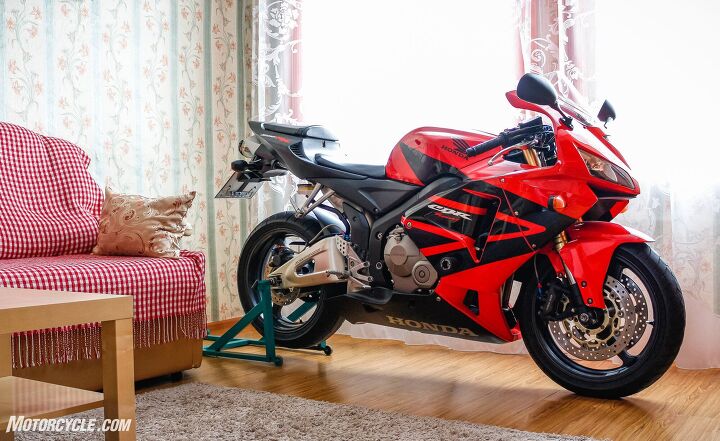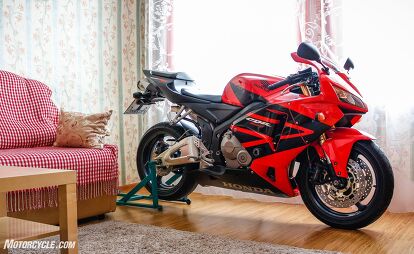Long Winter's Nap: Taking Your Motorcycle Out Of Storage

Storing your motorcycle can be bad for it, so treat it nicely before you ride
Waking your bike from its long winter’s nap is one of those good news/bad news moments. The good news is that, if you prepared your bike for the winter, getting back out on the road is pretty darn simple. The bad news is that, if you didn’t, you could be in for a bit of work (or more) before your motorcycle is ready to ride. While it may seem counter-intuitive, leaving your bike idle without preparing it is actually quite stressful on it. The volatile components in gasoline will separate and evaporate. The chemicals used to store electricity in the battery self-discharge. The air in the half-empty gas tank forms a microclimate in which any moisture has a chance to work its oxidizing magic on the exposed metal in the air pocket. Any corrosive materials left on a dirty bike get to gnaw away at it unchecked. Ozone will age the rubber parts. All of these are bad things.
Prevent Metal-on-Metal Violence
If you didn’t before the winter off-season (and even if you did), now is a good time to change your oil. Most of the crud in the oil has settled down into the oil pan, so you can get it out by draining it before you start the engine for the first time. The oil will be thick, so let it take its time in draining. Once you’ve added the new oil and filter, take it easy on the engine’s first start. Don’t crank up the choke or fast idle. Just let it run at the minimum rpm that it will idle smoothly. Remember, until the oil gets pumped back up the high points in the engine, there is the potential for metal on metal contact – which is a Very Bad Thing. Run your engine until it reaches its normal operating temperature before you ride.
We Have Ignition
When it comes to your electron depository, you want to make sure the battery has a good charge on it. If you stored your battery on a smart charger, congratulations, your battery is ready to party. If you didn’t, before you even think about turning the key on your motorcycle’s ignition, you need to fully charge the battery. Be prepared for it to need replacement because of the neglect. Since it’ll probably take a few cranks to get the engine running, you want the battery to be as strong as possible. To make it easier on the first start, be sure that the headlight is on low beam and any accessories you may have installed are turned off. (Having the first ride of the season thwarted because of a dead battery has made many folks firm believers in battery chargers.)
Fill’er Up
The gas tank of a properly winterized motorcycle is filled to the brim and treated with Sta-Bil or some other fuel stabilizer. In theory, all you need to do with a bike that was stored like this is start up and go. Some cautious riders will go through the extra step of draining the tank of this (still good) fuel and pouring it into their car’s tank where it will be diluted. Then they fill the bike’s tank with fuel fresh from the pump. This makes sure that everything is fine from the first compression stroke. Another popular – and much more fun – method is to simply go for a long ride to burn up the winter fuel in the tank. Then you get to put in fresh gas with a smile on your face.
If your tank was only partially filled and had no stabilizer in the fuel (Shame on you!), you absolutely should drain your tank. The volatile components that make your engine easy to start will have evaporated, leaving thicker, less combustion-friendly fuel behind. The thickness of the fuel can clog fuel injectors, leading to rough running, or worse.
Another issue is that, if your bike is carbureted, you should drain all the float bowls before trying to start the engine. While this may help prevent the jets from getting clogged when you first turn the engine over, varnish may have already settled in those tiny orifices as the bike sat throughout the winter, and you’ll need to pull the carbs apart to clean them.
Basic Maintenance
If you’re one of those people who couldn’t keep your mitts off your bike during the winter, you may have already done this, but it’s always nice to start the riding season with the basic maintenance chores complete. Lube the cables and all pivot points. Wash the chain with WD-40 or a chain cleaner and lubricate it after your first ride. If you didn’t change the brake fluid before the winter break, consider swapping it out now so that you get maximum performance out of the most important system on your motorcycle. Tires tend to lose pressure over time, so you must absolutely adjust your tire pressure to factory specifications. And why not give your bike a quick wash and wax to strut your stuff in the spring.
Have a great riding season!
We are committed to finding, researching, and recommending the best products. We earn commissions from purchases you make using the retail links in our product reviews and other articles. Learn more about how this works.
Become a Motorcycle.com insider. Get the latest motorcycle news first by subscribing to our newsletter here.

Like most of the best happenings in his life, Evans stumbled into his motojournalism career. While on his way to a planned life in academia, he applied for a job at a motorcycle magazine, thinking he’d get the opportunity to write some freelance articles. Instead, he was offered a full-time job in which he discovered he could actually get paid to ride other people’s motorcycles – and he’s never looked back. Over the 25 years he’s been in the motorcycle industry, Evans has written two books, 101 Sportbike Performance Projects and How to Modify Your Metric Cruiser, and has ridden just about every production motorcycle manufactured. Evans has a deep love of motorcycles and believes they are a force for good in the world.
More by Evans Brasfield







































Comments
Join the conversation
/laughs in Californian
https://video.search.yahoo....